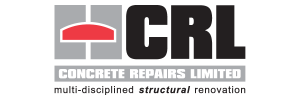Southampton Shellfish Scheme (2024)
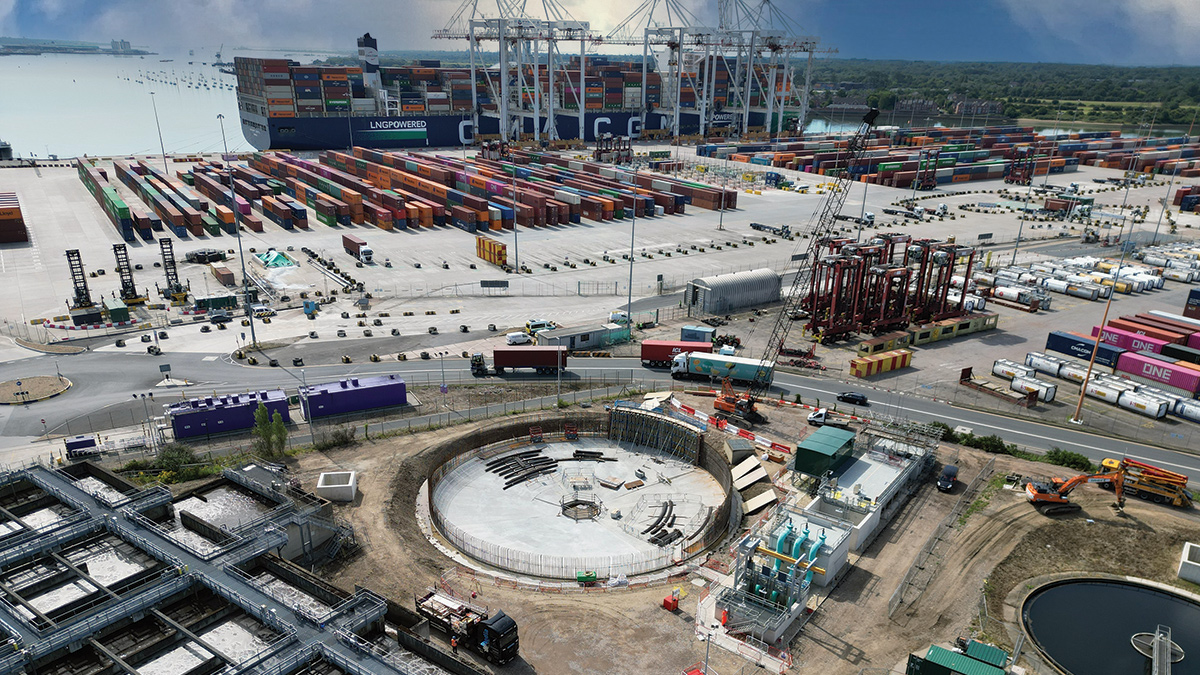
Southampton Western Docks with Millbrook UV irradiation system and FST under construction - Courtesy of Southern Water
The Southampton Shellfish Scheme comprises the upgrade to four wastewater treatment works and one combined storm overflow (CSO) discharging effluents to the Solent. The Water Industry National Environment Programme (WINEP) No Deterioration Shellfish Drivers (ND_SW) have dual targets: (i) to reduce the number of intermittent storm discharges to 10 significant spills or less per year (as a 10-year average) for the agglomeration of assets impacting Southampton Shellfish Water, and (ii) for the final effluent discharges, achieve a 6.6 log reduction in E. coli between crude sewage and the boundary of Southampton Shellfish Water. Additionally, WINEP U_IMP5 drivers resulting in an increase in flow to full treatment (FFT) were applicable at some of the sites, therefore design and construction for all drivers were combined under the same project.
| Site | Pre-U_IMP5 initial calculated volumes (m3) | Post Post U_IMP5 impact to agglomeration (June 2021) (m3) | Final Volumes (m3) |
| Millbrook WwTW | Yes | Yes | Yes |
| Slowhill Copse WwTW | Yes | Yes | Yes |
| Woolston WwTW | Yes | No | No * |
| Ashlett Creek WwTW | Yes | No | Yes |
| Ensign Park CSO | Yes | No | No |
| Table 1: Southampton Shellfish Scheme drivers | * N/A, but FFT is being increased as a mitigation for ND_SW driver | ||
Southampton Shellfish Scheme sites
The technical solutions considered during design included increasing the storm tank capacity and the hydraulic capacity of the wastewater treatment works (WwTW) to reduce the intermittent storm discharges, with UV irradiation or membranes being considered to achieve the disinfection requirements.
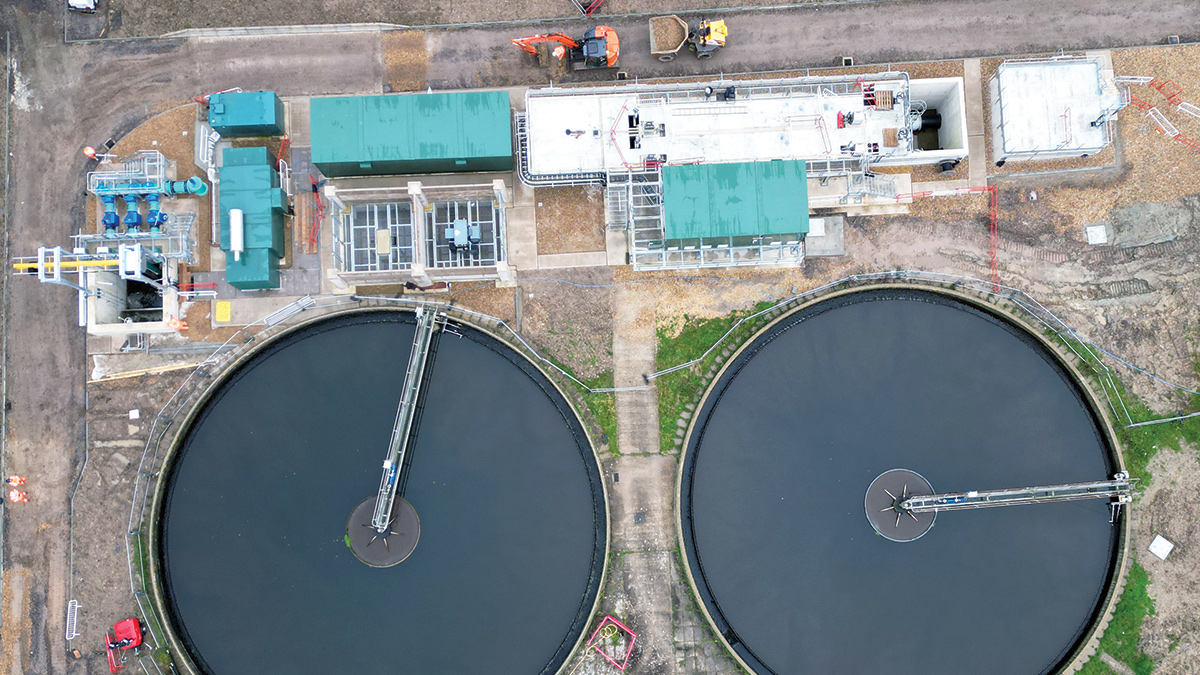
UV irradiation system at Slowhill Copse WwTW (December 2023) – Courtesy of Southern Water
Details of the five sites are as follows:
- Millbrook WwTW treats for a population equivalent (PE) of 147,000 with biological treatment provided using a 4-stage Bardenpho Activated Sludge Process (ASP).
- Slowhill Copse WwTW treats for a PE of 77,000 PE and provides biological treatment via a Modified Ludzack-Ettinger (MLE) configured ASP.
- Woolston WwTW treats for a PE of 70,000 and has an MLE configured membrane bio-reactor (MBR).
- Ashlett Creek WwTW treats for a PE of 15,000 and provides biological treatment via a sequential batch reactor (SBR).
- Ensign Park is a combined sewer overflow (CSO).
Modelling & optimisation of storm volumes
The project drivers required a reduction of spill frequency at storm overflows for all the catchments that discharge into Southampton Shellfish Water. This impacted five separate wastewater treatment works catchments.
Early in the design, the Southern Water (SW) project team identified an efficiency opportunity of combining the FFT U_IMP5 (increase in flow to full treatment) Driver with the Shellfish Driver, which had a significant impact on reducing the volume of the storm storage tanks. SW held regular meetings and agreed the approach with the Environment Agency (EA) including alignment of Regulatory output dates to the end of the AMP period.
The assessment of storm storage is based on the agglomeration approach outlined in the EA PR19 shellfish guidance and methodology. The definition of a significant spill was agreed with the EA at the conceptual stage of the scheme. This assessment treated all the discharges as a single agglomeration.
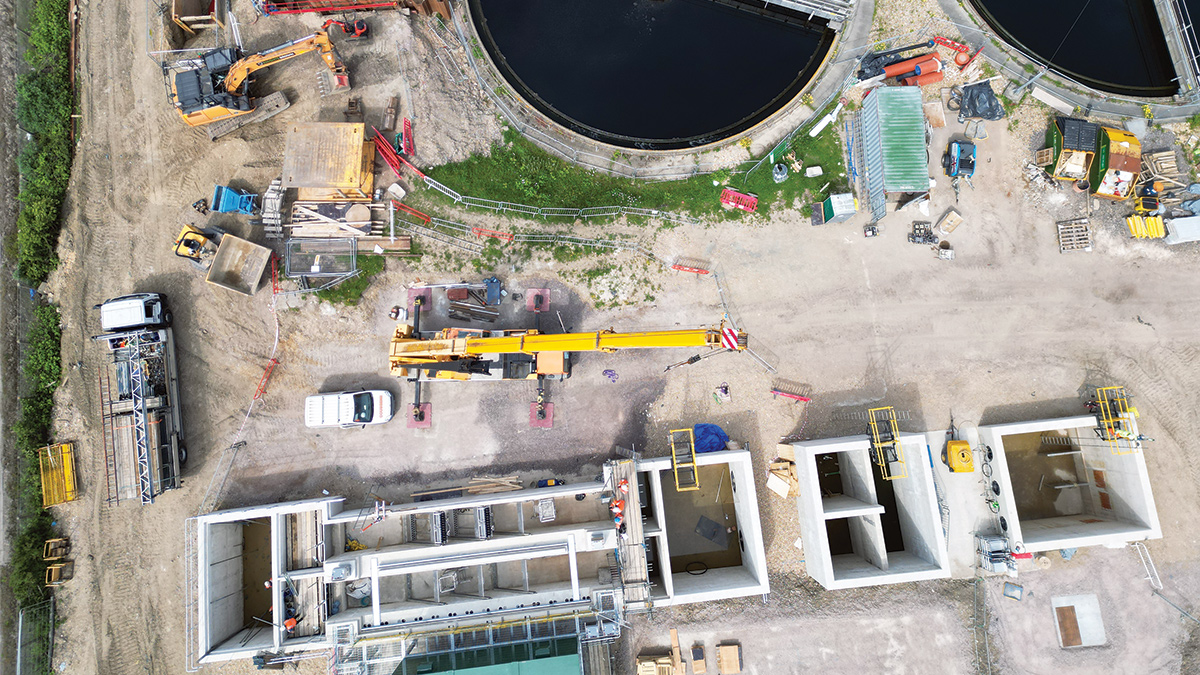
UV irradiation system at Millbrook (May 2023) – Courtesy of Southern Water
In summary, the integrated combined driver approach provided the following benefits:
- Avoided abortive investment:
- Storm tanks for ND_SW being oversized (increased FFT from U_IMP5 reducing storm flows).
- UV irradiation system and associated feed pumping for ND_SW being undersized (increased FFT from U_IMP5).
- Reduced carbon impact:
- By avoiding assets no longer required.
- By avoiding an inefficient 2-stage construction approach.
- Avoided potential abortive third party land acquisition and development.
- Reduced construction, traffic movements and the impact to the local community, particularly within the urban areas.
- Avoided unnecessary impact to the environment and ecology.
- Avoided potential abortive works for 3rd party infrastructure (for example, power upgrades).
To develop the solutions required at each wastewater treatment works, the sewer network performance for the five catchments was designed using a 10-year rainfall dataset. The observed spill frequencies across the catchment had to be agglomerated to ensure that 10 significant spills or less per year was achieved over a long-term (10 year) average.
This meant the modelling was more complex and took a lot longer than a usual model build and verification exercise because of the need to assess all five catchments together.
Following subject matter guidance from across the industry, the project team used an innovative approach of using an extended rainfall series duration and a single rain gauge. In addition, the team targeted the storage volumes at sites where there was available capacity to arrive at the most efficient storage volumes that were significantly lower than the original estimates, all while complying with good industry practice. In summary, this included:
- Extending the rainfall series for a longer period than 10 years to be more representative of long-term weather patterns, addressing extremely ‘wet’ periods within the original 10-year series.
- Using a single rainfall profile as this coastal rain gauge is more representative of the rainfall falling on the main urbanised sections of the catchments.
- An extended rainfall series to help address the annual frequency, extremeness and year-on-year variability of rainfall patterns and particularly wet or dry periods.
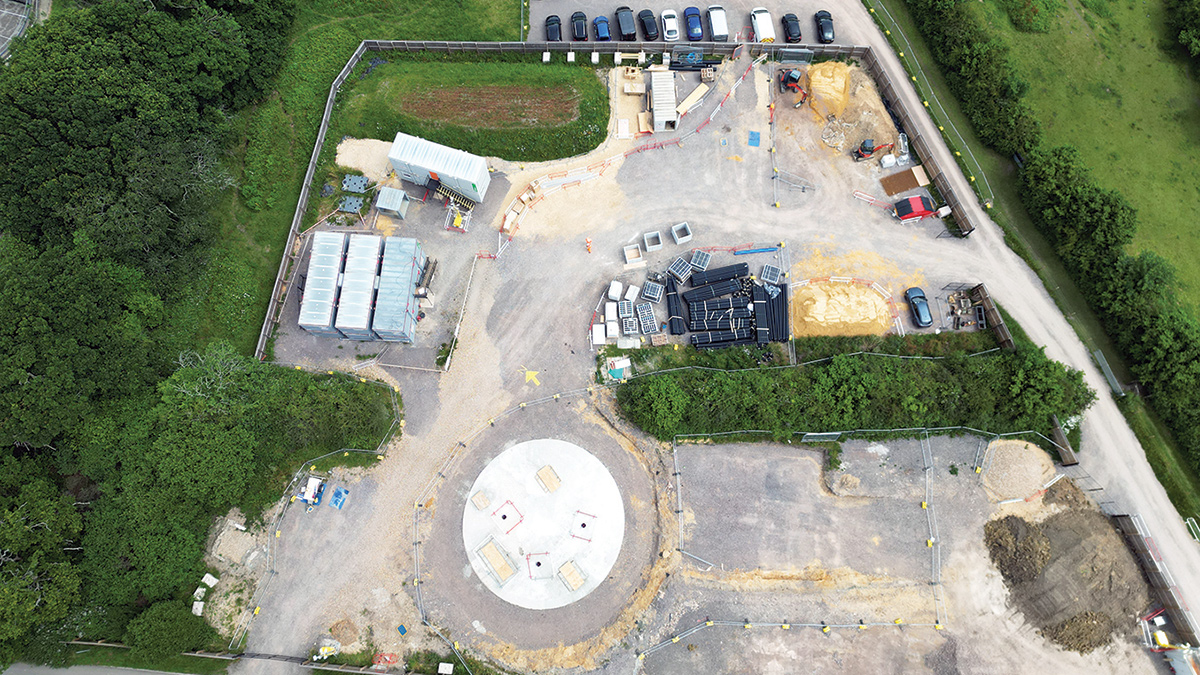
Storm Shaft in Ashlett Creek (June 2024) – Courtesy of Southern Water
Optimising storm storage volumes
The project team considered the best location for increasing the capacity of storm storage considering the cost/benefit for reducing significant storm spills. For example, at Millbrook WwTW redundant storm tanks were utilised that provided a volume of 3,140m3. The increase in volume at Millbrook enabled the storage volumes to be optimised across the agglomeration of sites with volumes being offset against other more constrained sites.
Southampton Shellfish Scheme: Supply chain – key participants
- Client: Southern Water
- Delivery partners & outline/detailed design: GTB
- UV design & coastal & network modelling: Stantec UK
- Coastal & network modelling: Southern Water
- Civils & pipework: Knights Brown
- Civils & pipework: Impact Formwork
- Storm shafts & tunnelling: HB Tunnelling
- Piling works (Woolston WwTW): Rock & Alluvium
- Piling works (Woolston WwTW): Keller Foundations
- Storm tank remedials: Concrete Repairs Ltd
- Mechanical installation: Bridges Electrical Engineers Ltd
- Mechanical installation: Steelway
- Electrical installation: Field Systems Design
- Electrical installation: Loxton Electrical
- ICA: Total Automation & Power (TAP)
- MCCs: MCS Control Systems
- GRP kiosks: Industrial GRP Ltd
- Penstocks: Ham Baker
- UV: Trojan Technologies
- Membranes: Koch (KMS)
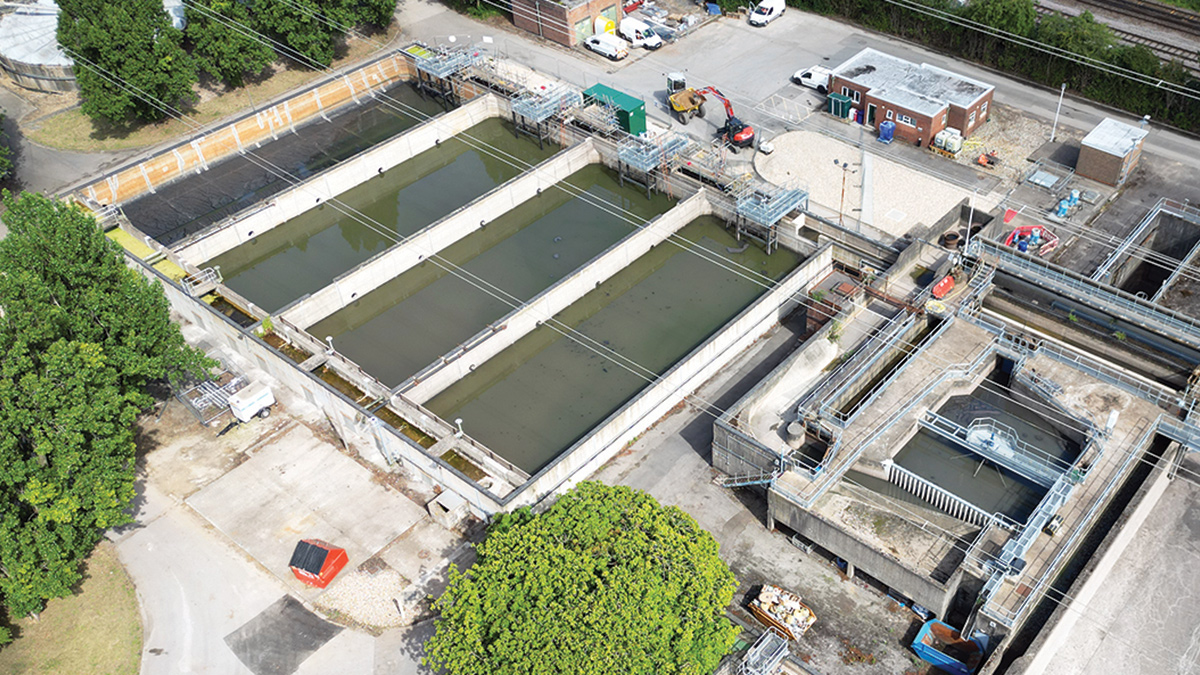
Refurbishment of redundant storm tanks at Millbrook to provide 3,400m3 capacity – Courtesy of Southern Water
Infiltration – optioneering
- To optimise the significant storage volumes at the works, sustainable catchment opportunities were considered for the large, urbanised Millbrook and Woolston catchments by the removal of specific areas of groundwater infiltration and surface water from foul sewers.
- The optioneering was undertaken using an optimisation software package to target impermeable areas (roads and roofs) connected to the network and working through simulations (up to 20,000) to assess parts of the catchment where connected roads and roofs could be removed from the foul sewer.
- The benefit was not as expected when considering the agglomerations due to spills from the other assets. In addition, the timescale to achieve long-term reduction from impermeable area removed or groundwater infiltration would require a multiple AMP period.
- Future opportunities using the optimisation techniques will be considered for similar CSO and storm spill frequency schemes to achieve sustainable catchment opportunities, by the removal of specific areas of groundwater infiltration and surface water from foul sewers.
Woolston WwTW – increasing FFT
The initial significant storm volumes at Woolston were extremely challenging given the location of the site within an urban environment and lack of available space. The project team identified an opportunity of increasing the FFT at Woolston, which provided a significant reduction in storage. The scope involved utilising hydraulic headroom within the works, and through the installation of additional MBR capacity and associated pump upgrades, enabled a 20% increase in FFT at Woolston WwTW (427 l/s to 534 l/s).
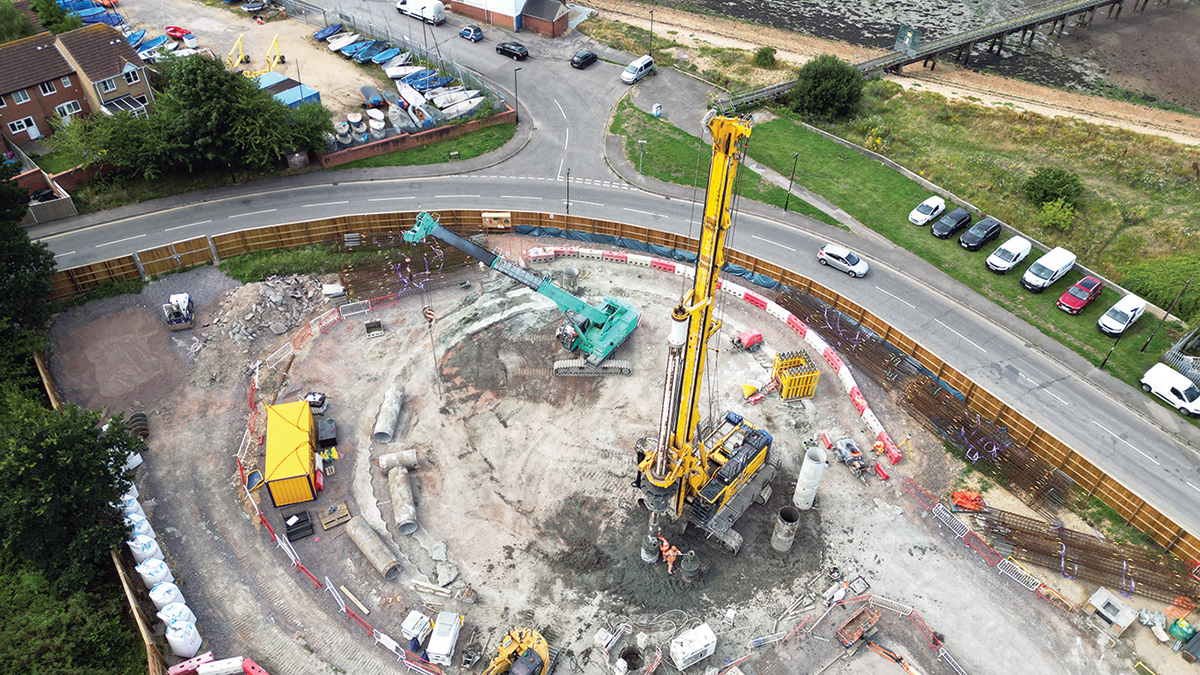
Construction of the shaft at Woolston – Courtesy of Southern Water
The programme to deliver the increase in FFT at Woolston was short and provided an early reduction in E. coli concentration discharging to the Solent. This early delivery reduced 20% of the total E. coli concentration across the agglomeration of sites and was fundamental in agreeing new regulatory dates for the SW_ND (storm storage) drivers. The combination of the integrated driver approach to reducing spills, the innovative modelling and optimisation of assets reduced storage volumes by circa 46,000m3.
The final volumes are as shown in Table 2:
| Site | Initial calculated volumes (m3) (pre-U_IMP5) | Post Post U_IMP5 impact to agglomeration (June 2021) (m3) | Final Volumes (m3) |
| Millbrook WwTW | 3,684 | 200 | 3,400 |
| Slowhill Copse WwTW | 13,678 | 2,000 | 2,000 |
| Ashlett Creek WwTW | 4,176 | 1,650 | 1,650 |
| Woolston WwTW | 27,422 | 13,120 | 5,000 |
| Ensign Park CSO | 3,806 | 280 | 280 |
| Blechynden Terrace CSO | 5,000 | 0 * | 0 * |
| Newtown CSO | 562 | 0 * | 0 * |
| Table 2: Southampton Shellfish Scheme storm storage volumes |
* Reduction driven by reduced spills in the agglomeration | ||
New final effluent disinfection at Slowhill & Millbrook WwTWs (AMP7 & AMP8):
In response to a number of drivers, the EA has recently revised its approach to design and permitting of UV irradiation systems for the disinfection of final effluent. The aim is to move away from the use of generic assumptions, to follow international best practise with an approach which employs the use of a site-specific data in conjunction with performance validated UV irradiation equipment. This revised approach enables development of a significantly better understanding of performance and limitations on a site-specific basis.
Understanding the variation and impact of key wastewater characteristics on parameters such as UV transmittance and the UV dose-response relationship enables selection of a representative design envelope and minimum target UV dose. This enables the capital solution to be optimised, minimises power usage, operational costs and carbon impact while securing environmental performance.
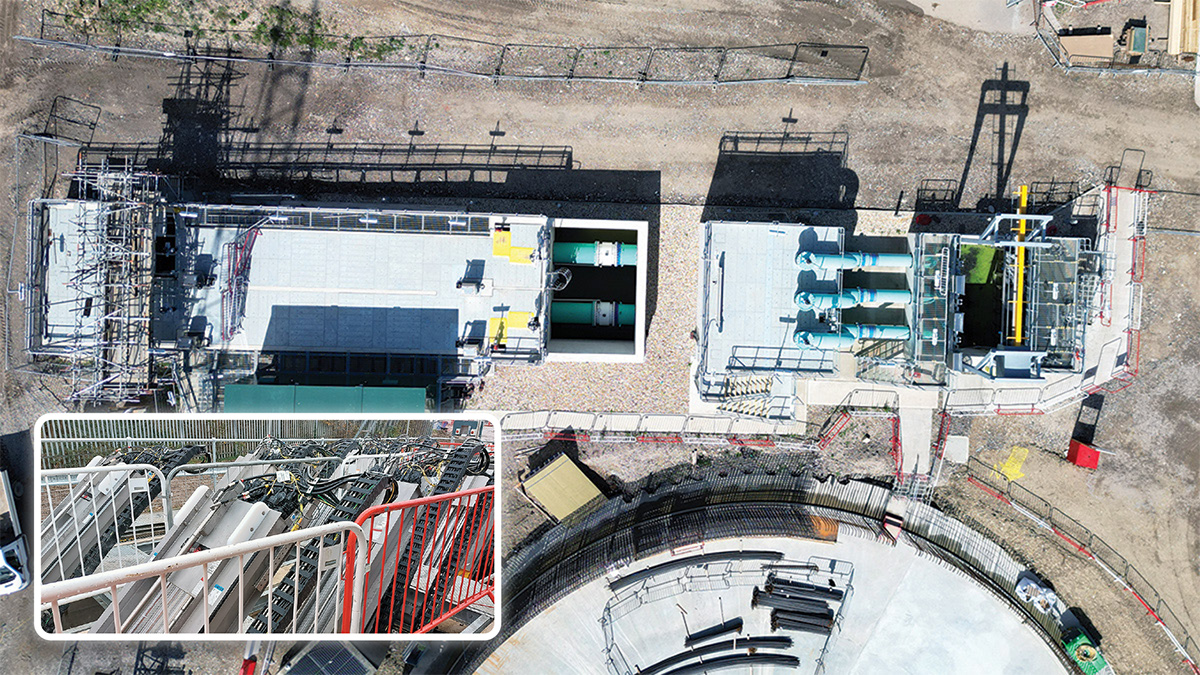
UV irradiation system at Millbrook (June 2024) post commissioning/FST under construction and (inset) UV irradiation system at Slowhill Copse WwTW – Courtesy of Southern Water
The steps undertaken for the development of the design parameters and permit conditions for the UV irradiation systems at Slowhill and Millbrook WwTWs can be summarised as follows:
- Coastal/estuary modelling was used to determine the dilution/dispersion factor available from the effluent discharge location to the Shellfish Water boundary. The boundary is due to extend closer to the discharge points in AMP8 (i.e. reducing the available dilution of the final effluent discharges), therefore disinfection targets were evaluated for both AMP7 and AMP8 during design. This enabled the overall system (channels, MCC and power requirements) to be designed with the ability to install the equipment required in AMP7 and accommodate further banks to meet the lower E. coli targets required to avoid abortive and/or extensive additional construction in AMP8.
- A programme of sampling and analysis was carried out (from April 2020 to May 2021) to collect data on the variation of microbial and sanitary characteristics of the final effluent. The results were compared to the parameters available from historical site data in order to ensure that the sampling was representative of the expected range. Variation in UV transmittance was recorded using online instruments for assessment with flow data to understand their relationship. The UV dose-response relationship for E. coli for the final effluent was developed using collimated beam testwork to determine the target UV dose required to achieve the disinfection targets for permitting for both AMP7 and AMP8.
- The data was used to develop a range of design parameters that were then used in conjunction with UV suppliers’ performance validation information to determine a range of UV irradiation system configurations. The options were evaluated considering the different levels of resilience, redundancy and risk of non-compliance with the EA’s proposed new permit conditions.
The new UV irradiation systems have been in operation at both sites since Autumn 2023 and are consistently achieving concentrations of E. coli in the final effluent discharges that will maintain the concentration at the Shellfish Water Boundary below the post PR19 target value of 5 cfu/100ml as a geomean.
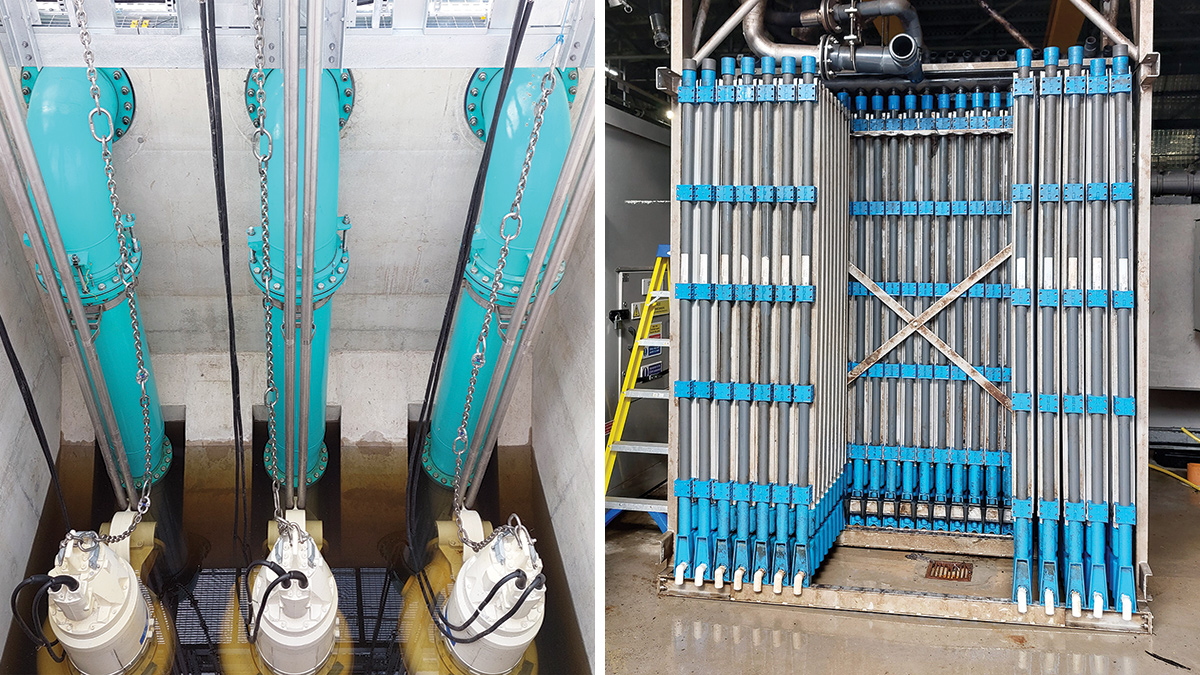
(left) Millbrook UV pumping station and (right) MBR cassette capacity being increased in Woolston WwTW – Courtesy of Southern Water
Woolston WwTW – working with care
Due to the limited availability of operational land in Woolston, the new storm shaft is being constructed beneath a car park and green area own by Southampton City Council (SCC), the area also had a Multi-Use Games Area (MUGA). The project team and the representatives of the Council engaged in extensive discussions prior to submission of the planning application which ensured a positive outcome for both parties.
From those conversations the project team learnt that the Council had worked to create a low nutrient coastal grass environment in the zone affected by the project. The topsoil had been amended and sown with the current species in previous seasons. Therefore, the agreed approach was to retain the topsoil stored on site and reinstate it at the end of the project, enabling the green area to grow and cover the old disused carpark.
The first activity after site mobilisation was relocating the reptiles that naturally inhabit coastal grass biomes. All areas with long grass that were part of the construction compound had the grass cut in two passes to encourage reptiles to move to nearby unaffected zones. Additionally, the top 100mm of soil was hand excavated with an ecologist carefully moving those reptiles still on site.
SW, working closely with the local Council, has ensured that the pre-existing facilities not only are kept despite the new structures being built, but that they are also improved. The number of parking bays and EV charging points will be maintained with improved access arrangements to avoid unwanted camping vans. The MUGA will be improved so the excessive slope that the old court had is removed and the pedestrian access to an adjacent park is protected with bollards, as previously vans used to park using part of the footpath.
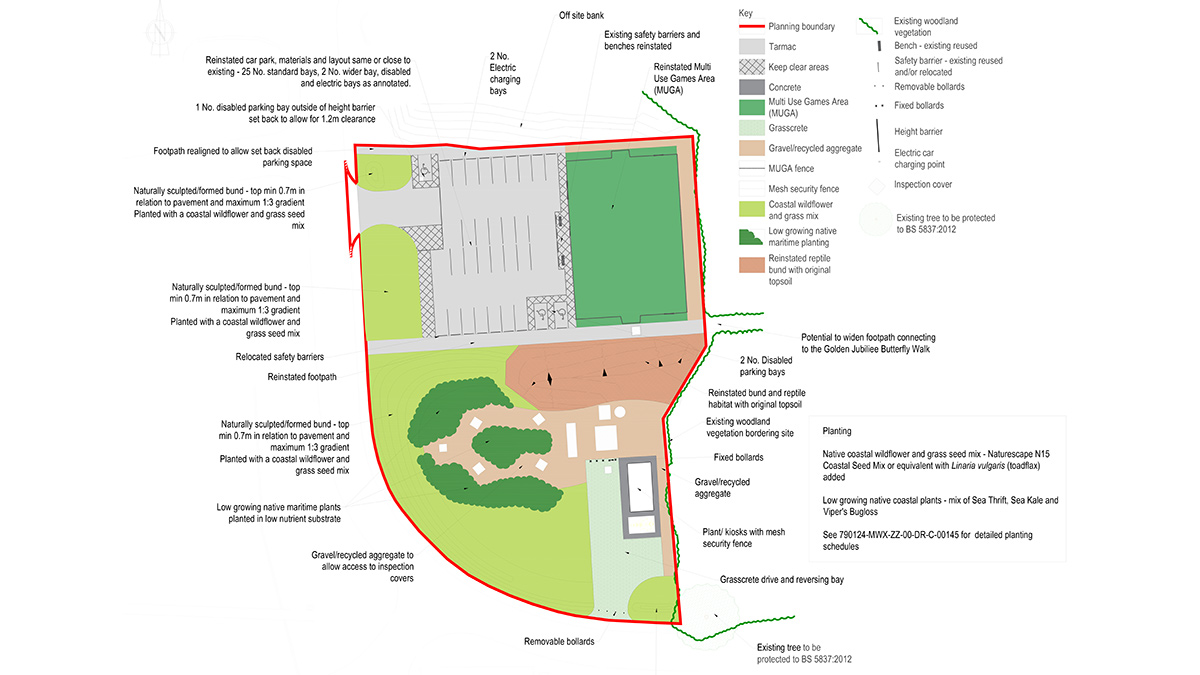
Landscaping over Woolston storm shaft – Courtesy of Southern Water
Progress to date, successes and future phases
The storm tank at Millbrook WwTW and the increase in flow to treatment at Woolston WwTW were both commissioned in July 2022 while the projects to install UV irradiation at Slowhill and Millbrook WwTWs were commissioned in Autumn 2023. In combination, these improvements represent a reduction of 72,500 cfu/s of E. coli being discharged to the Southampton Shellfish Waters, which is more than 60% of the total E. coli concentration reduction when all the projects are completed.
Results from sampling carried out after commissioning have demonstrated that both UV irradiation systems at Slowhill and Millbrook have reliably achieved the target efficacy, with concentrations of E. coli in the effluent post disinfection regularly below 200 cfu/100ml. Additionally, concentrations of E. coli in the final effluent discharge from Woolston have been consistently below 35 cfu/100ml since July 2019, following commissioning of the MBR.
The next key milestones are 31 December 2024, when the new storm tank at Ashlett Creek WwTW will be commissioned, and 31 March 2025, when all the remaining storage and increase in flow to treatment drivers will be completed.
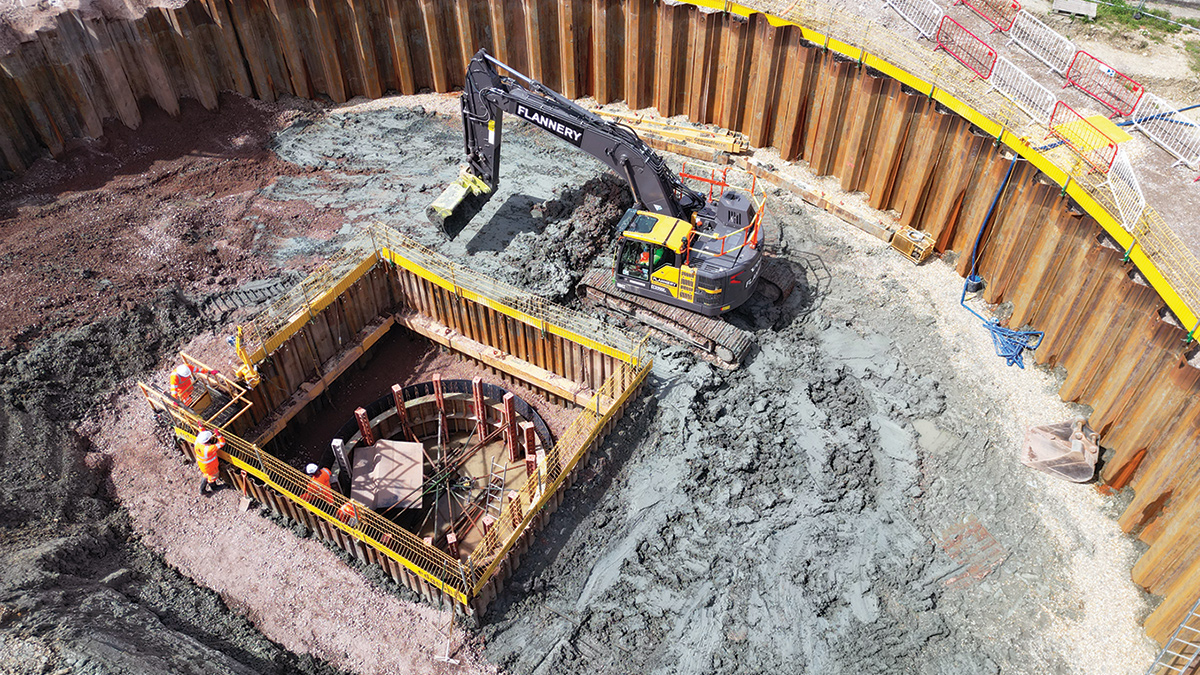
FST construction at Millbrook (June 24) - Courtesy of Southern Water







